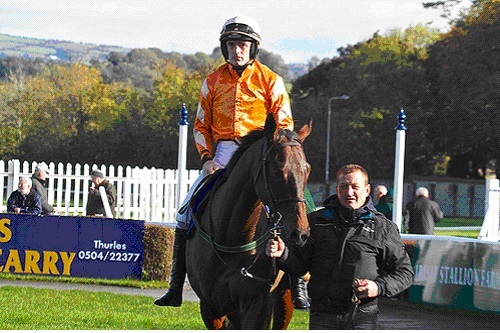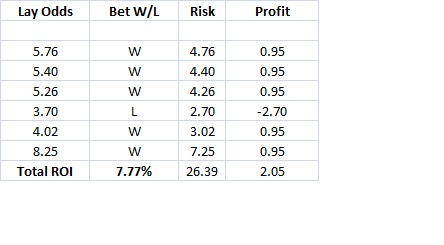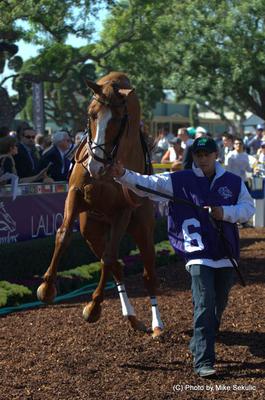Betting tips on determining Return On Investment (ROI)
 Punters Friend Jockey Ruby Walsh
Punters Friend Jockey Ruby WalshFollow these Pro betting tips for Return On Investment and why we should use it!
What is the difference between profit and Return On Investment (ROI)?
We obviously wish to know how much money we are going to make but there are different routes to the same goal; and some are rocky and hard.
How much money can you realistically earn from betting on the horses?
This is a question frequently on the lips of novice punters and the answer lies in how much you can afford to invest.
The crucial point is to see yourself as a professional bettor where your time and money are viewed as an investment. Thus the more you can invest the greater your return and it is important to have some idea of your likely return on investment.
Obtaining good odds for your bets is also crucial in maximising the chance of making a profit over time.
 Bookmakers On Course
Bookmakers On CourseWe need to look beyond the profit figures alone and analyse two important elements of our betting
1 - How many points of our bank we can use to bet with
2 - How much we are prepared to risk
Let's look at these two things a little closer.
If our betting tips have given a profit of 100 points per month then it is natural to assume that everything is rosy!
However if it is revealed that your bank needs to have a 1000 points to bet these selections it soon becomes apparent that although the profit is still good it is not quite as impressive as we first thought. Hence the importance of knowing how many points we need to bet with.
Supppose we followed the selections of 2 different tipsters and during the course of a month one tipster made 100 points profit and the other made 20. First impressions suggest that the tips producing 100 points are much better.
But if it became apparent on closer inspection that you had to risk 200 points to get your 100 points profit whereas the other tipsters selections required risking only 5 to make 20 points profit then the service producing 20 points is actually excellent value.
Assessing Betting Tips
We need to find a better way to assess which selections offer the best value and it's called Return On Investment or ROI for short.
The ROI gives us an exact profit value for every 1 point invested. In effect it reveals our profit levels irrespective of whether our tips require more points to bet or if they risk more for their profit.
ROI is how much profit is returned relative to how much you have bet.
Going back to our earlier example of the two tipsters, one making 100 points profit and the other making 20.
The 100 points profit selections produce ROI figures of 50% and the 20 points profit selections 400%.
This reveals that when comparing the return on your investment the 20 points profits service is eight times better!
This makes our decision of which tipster to follow a whole lot easier.
Calculating ROI
So - how to calculate ROI? The maths is very simple and anyone can do it. To start we need to establish:
a. How much has been bet (Stake)
b. How much has been returned (Profit)
When calculating the return we need to remove the stake element to arrive at the profit.
eg if you bet £10 at odds of 3.0 then your return would be £30 of which £10 is the original stake so your profit is £20
This profit figure is used to calculate the ROI as follows
Profit divided by your Stake = Return On Investment (ROI)
Et voila - we have the magic figure!
Over the last week we may have placed £100 in bets. At the end of the week we calculate we have made £45 in profit.
To calculate the ROI our £45 is divided by £100 = 0.45
To make this easier to understand we turn this into a percentage by multiplying our ROI by 100.
0.45 multiplied by 100 = 45%
The ROI from our betting tips is 45%. A pretty good return!
It's well worth doing this regularly as part of your betting strategy
 Racing at Sligo
Racing at SligoThere are two types of professional bettors - the one who studies form and specializes in one or more areas of betting and the other uses technology to gain an edge in the market.
The form student will start the day by identifying potential bets in his specialist area and then spend time assessing the form. This will result in a small number of bets for the day on which he can expect to see a return of between 20% - 40%. His bank will need to be large in order to make a decent return.
The other type of bettor who relies on computer technology uses it to analyse large data sets which then feed the information into betting bots to place the bets at great speed.
These systems usually find a much greater number of bets per day and in consequence the stakes will be smaller and will only make between 5% - 7% return on investment.
Whichever method you use the crucial factor is the long term return. Say we use a tipster who produces an average return of 20% from 100 selections per month at a cost of £50.
If we were to place £10 on each selection we would expect a profit of £200 less the tipster fee of £50 to give a total profit of £150.
Armed with these figures we stand a much better chance of winning the battle against the bookies.
When we are deciding if our betting tips are worth placing, it's important to use not only Return on Investment (ROI), but also Strike Rate and Profit.
What are we looking for in our tips?
A good profit and a good ROI.
Our first consideration is to consider profit levels. We need to sort by the most profitable tips first.
We then need to assess the ROI and strike rate.
Although low strike rate tips (below 10%) can result in good profits, the losing runs can be intimidating and a cause for concern.
So it may be best to avoid tips with a strike rate of less than 10%. Although it's worth remembering that even if we are only winning 1 out of every 10 bets we can still make a good profit.
The higher the strike rate then the better our tips. Usually you will find that on win bets the higher the strike rate then the lower the profit. However this is where we want to use ROI.
If we go for a high strike rate the wins will come more regularly but the returns per win will be less.
This is where we can use the ROI to determine the best strategy for our own personal comfort levels and find a source of tips that will play to your strengths.
If you are new to betting then the higher strike rate would probably be more suitable.
Whether you make a success of your betting tips will depend on getting the balance right and not allowing yourself to become distracted by losing runs.
Calculating ROI for Lay Bets
This is a slightly different calculation than for Win bets because we need to sum the value of our risk to the market.
With lay bets we take the bookmaker's role and risk losing the odds x the stake.
In the table below the Lay odds appear in column 1
The next column shows whether the lay was successful or not
The 3rd column shows how much we risked ie the odds less the bettors stake of 1 unit
The Profit column shows how much profit we make after the Betfair commission 0f 5%
The last line shows the total amount risked (26.39), the Profit of (2.05) and the ROI 7.77% which is calculated by dividing the profit by the amount risked and multiplied by 100 to give a percentage.
The ROI for lay betting is usually a lot less than for win betting, but to compensate, the strike rate is usually much higher, as it is far easier to pick losers than winners.
 ROI Lays
ROI Lays
You Might Like These
Kentucky Derby Odds: Will there be a hometown favorite?
Preakness Stakes Odds: Will the champions face fresh challengers?
Belmont Stakes Odds: At 1½ miles, stamina becomes the great equalizer as longshots can threaten.
Breeders' Cup Odds: International talent collides with American speed, reshuffling expectations across the board.
Dubai World Cup Odds: Under desert lights, can a Japanese sensation prevail against the world's elite.
Pegasus Cup Odds: Retirement beckons for champions seeking one final payday at America's richest race.
Bet on Horses: Every wager tells a story of hope against mathematical probability.
Kentucky Derby Betting: Beneath fancy hats and mint juleps, fortunes change hands with each thundering hoof.
Preakness Stakes Betting: The middle jewel rewards those who recognize when Derby form holds true.
Belmont Stakes Betting: Distance separates champions from pretenders when the final furlong tests them all.
Breeders Cup Betting: Global racing converges for two days where value hides in plain sight.

Returns Policy: Once a customer has agreed to pay for a product or service no returns will be permitted or payments returned.
All PayPal transactions are subject to the PayPal Privacy Policy
Privacy Policy: Personal details provided to this site by an individual may be shared with third parties unless requested otherwise.
Above policies updated 15 March 2018




